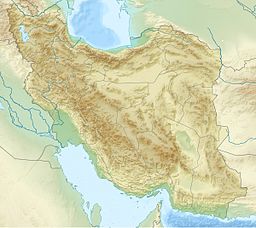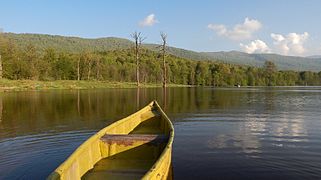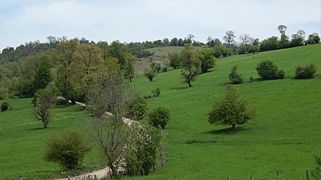| Alendan lake | |
|---|---|
 View of lake in spring | |
| Coordinates | 36°13′29″N 53°27′34″E / 36.22472°N 53.45944°E |
| Type | lake |
| Primary inflows | rain |
| Primary outflows | none |
| Surface area | 17–30 ha (42–74 acres) |
| Settlements | Alendan, Sari |
 | |
Alendan lake (Persian: دریاچهٔ الندان) is a lake with 17 hectare span located in Sari County. This lake belongs to Quaternary era and has recorded in The national index of Iran in 2015.[1][2][3]
This lake is also called Pelle Azni because of the nearby village, Azni.[4] The lake has a 70 km distance from Sari and is located on Sari-Semnan road. (About two hour way from Semnan)[5] The lake is 1200 m higher than sea level.[6]
This lake is the main source of water for paddy fields of near villages like Azni, Mazarostaq, Konta, Didu and Zalam.[4] However no river water comes to the lake, rain full fills the lake.[7]
Plenty of various trees, including Carpinus betulus, oak, Ulmus glabra and Tilia, surrounded the lake.[8]
Gallery[edit]
See also[edit]
References[edit]
- ^ "Alendan lake of Sari". Makanbin (in Persian). Archived from the original on 9 July 2013. Retrieved 17 November 2016.
- ^ "report of Alendan lake". Mehr news (in Persian). 2012. Retrieved 17 November 2016.
- ^ Raghimi, Reza (2013). "Alendan lake". ISNA (in Persian). Retrieved 17 November 2016.
- ^ a b "Where is Alendan lake?". YJC (in Persian). 2014. Retrieved 18 November 2016.
- ^ "Alendan lake to Semnan". Tishineh. Retrieved 18 November 2016.
- ^ "Alendan lake". See Iran (in Persian). Retrieved 18 November 2016.
- ^ "Alendan lake". Sari City (in Persian). Archived from the original on 18 November 2016. Retrieved 18 November 2016.
- ^ "Images from Alendan lake". Fararu (in Persian). 2012. Retrieved 18 November 2016.






Well, that’s interesting to know that Psilotum nudum are known as whisk ferns. Psilotum nudum is the commoner species of the two. While the P. flaccidum is a rare species and is found in the tropical islands. Both the species are usually epiphytic in habit and grow upon tree ferns. These species may also be terrestrial and grow in humus or in the crevices of the rocks.
View the detailed Guide of Psilotum nudum: Detailed Study Of Psilotum Nudum (Whisk Fern), Classification, Anatomy, Reproduction